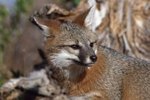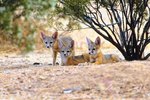
The desert pocket mouse (Chaetodipus penicillatus) is a territorial, predominantly nocturnal rodent that is widespread throughout southwestern regions of the United States and northern portions of Mexico. Desert pocket mice, like the vast majority of other smallish creatures, have a handful of key predators in the animal kingdom.
Background Information
These solitary rodents, at full maturity, are generally no longer than 7 inches and usually weigh about half an ounce. Their fur tends to be grayish-yellow or grayish-brown, though their undersides and tails are markedly paler. They gravitate to dry and airy desert settings, as their monikers suggest. They also tend to stay away from rugged terrain. Desert pocket mice establish residences in spacious subterranean burrows. Their lifespans are brief -- it's uncommon for them to exceed a year in age. Some of their close relatives include rock pocket mice (Chaetodipus intermedius), hispid pocket mice (Chaetodipus hispidus) and Bailey's pocket mice (Chaetodipus baileyi). Female desert pocket mice typically give birth to litters of between one and seven youngsters. Their reproductive season starts at the beginning of the spring and wraps up at the end of the summer.
Predators
Snakes and owls are among the animals that routinely make meals out of desert pocket mice. The sidewinder (Crotalus cerastes), also known as the horned rattlesnake, competes for a tasty bite of mouse with the common barn owl (Tyto alba) and great horned owl (Bubo virginianus), all of which are major predators of pocket mice. Some flesh-eating mammals also prey on them sometimes -- think weasels and coyotes.
Predator Defense
Desert pocket mice usually forage for food at night. Under cover of darkness, they often employ the shrubs they feed off as helpful protection against the vigilant and threatening gazes of certain types of predators -- namely owls. Mesquite shrubs, for example, are a common protective haven for these small rodents.
Diet
Apart from a few exceptions, desert pocket mice do not generally behave as predators themselves. Meat is not a big part of their diets. These rodents have broad sustenance preferences, regularly feeding on seeds -- specifically those of the aforementioned mesquites, as well as from broomweed and creosote bushes. They sometimes eat grass and other plants, including weeds. Once in a while, desert pocket mice eat bugs and larvae -- the only animals in their diets. They possess handy cheek pouches that they use for brief stashing away of food. If they need to save food for longer periods of time, they use their burrows instead.
References
- Natural Science Research Laboratory: Desert Pocket Mouse
- Smithsonian National Museum of Natural History: Desert Pocket Mouse
- University of Michigan Animal Diversity Web: Chaetodipus penicillatus
- VRHCRP: Desert Pocket Mouse
- Lower Colorado River Multi-Species Conservation Program
- The Bureau of Land Management: Desert Pocket Mouse
- Utah Division of Wildlife Resources: Desert Pocket Mouse
- IUCN Red List of Threatened Species: Chaetodipus penicillatus
Photo Credits
-
Jupiterimages/Comstock/Getty Images




